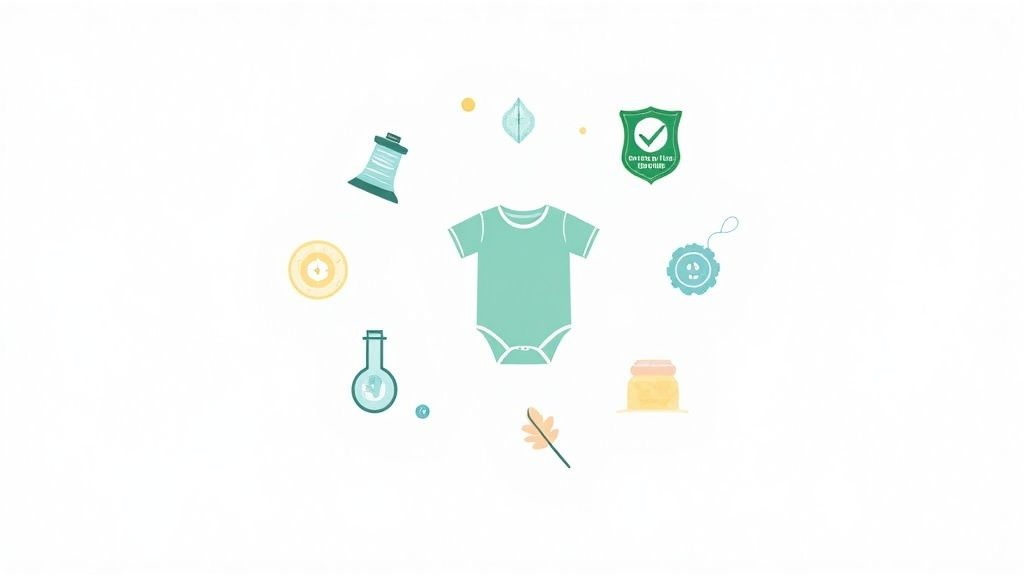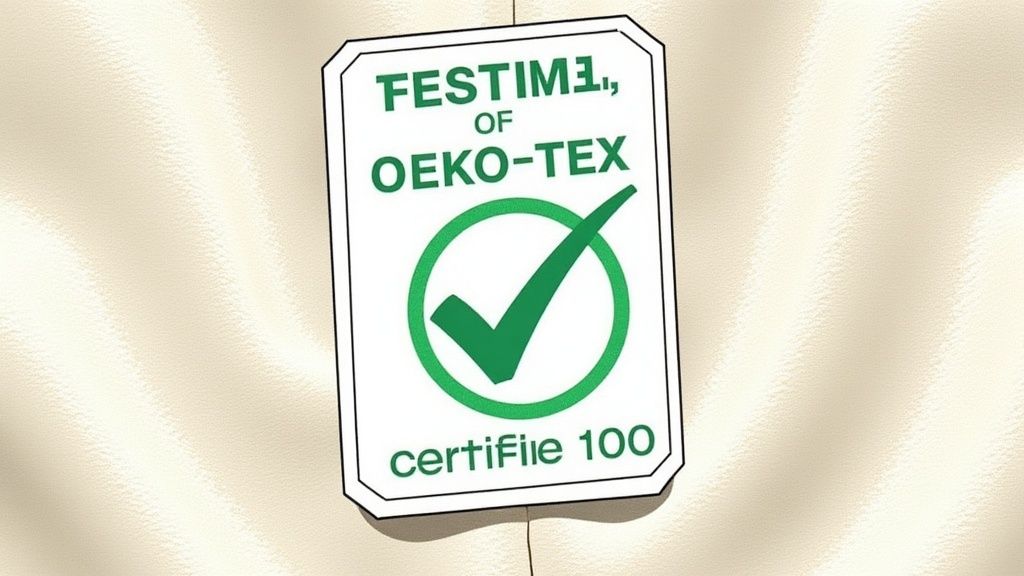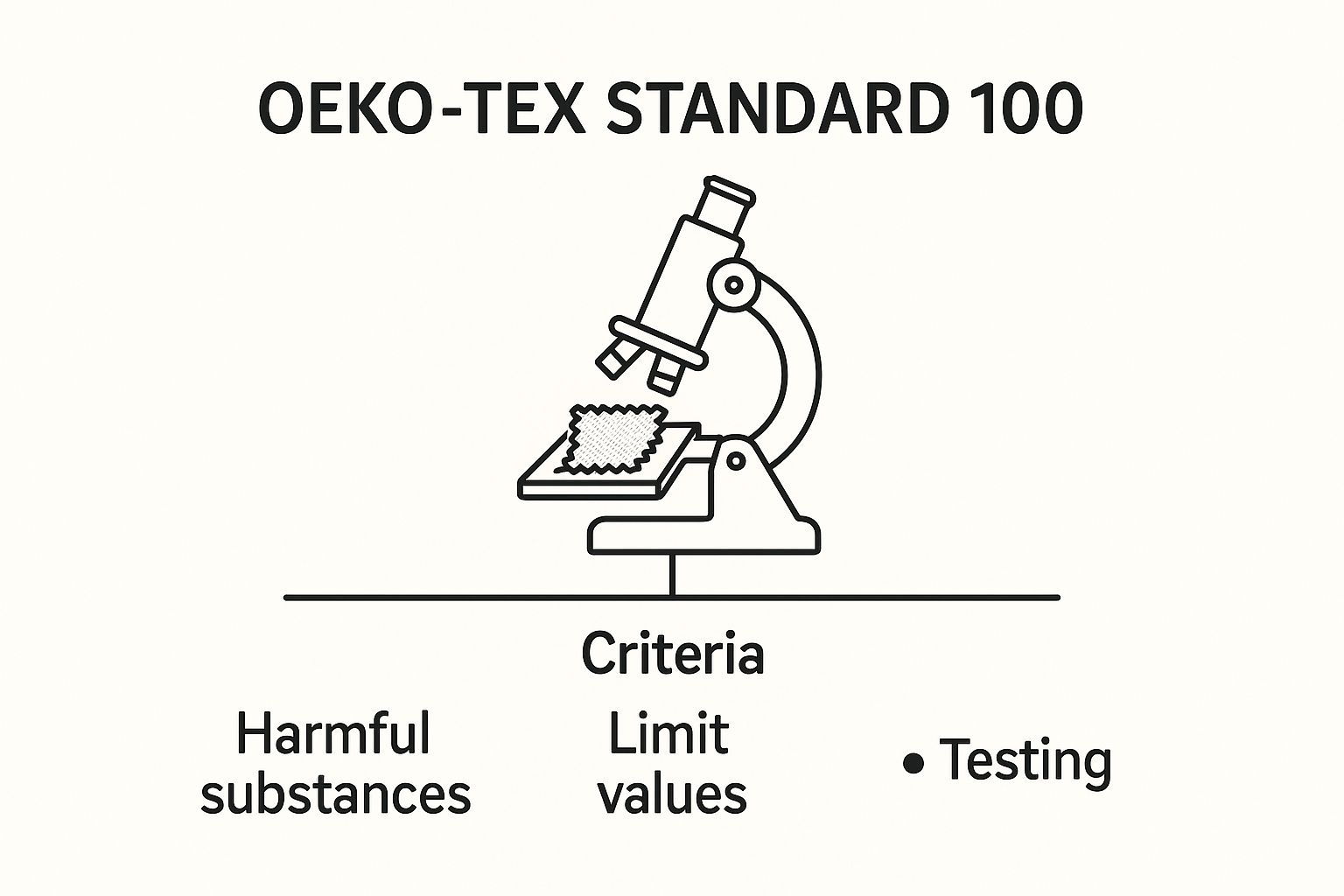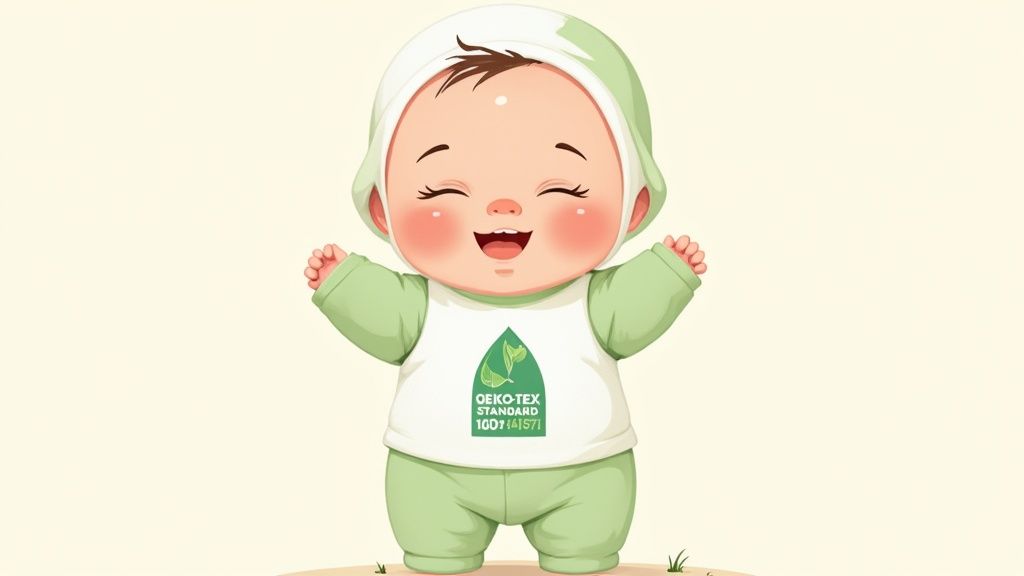
What Is Oeko Tex Standard 100 and Why It Matters
Share
Ever seen that little “Oeko-Tex” label on a set of sheets or a baby onesie and wondered what it was all about? Think of it as a global seal of approval for fabrics.
Simply put, Oeko-Tex Standard 100 is a certification that tells you a textile product is safe for human health. It’s a guarantee that every single part of an item—from the thread and buttons right down to the zipper—has been tested and cleared of a long list of nasty chemicals.
A Health Check for Your Family’s Fabrics

You can think of the Oeko-Tex Standard 100 label as a really strict, independent health inspection for the stuff you and your family use every day. It’s not just about the main fabric; they scrutinize every single component. The dyes, the sewing thread, even the little plastic snaps—it all goes under the microscope.
The core promise behind this label is 'Confidence in Textiles.' It's a straightforward way for you to know that the clothes you put on your baby or the bedding you snuggle into are genuinely harmless. This is a big deal, because a lot of fabrics can hold onto chemical residues from the manufacturing process.
This global standard was actually created back in 1992 to tackle these very concerns. People were getting more worried about what was in their clothes, and this certification gave both companies and shoppers a reliable way to ensure fabrics met tough safety standards. If you're curious, you can explore the full history of the Oeko-Tex Standard 100 to see how it all started.
Essentially, this little label builds a bridge of trust. It takes the complicated world of textile chemistry and boils it down to one simple, reassuring symbol. When you see it, you know the product has passed a rigorous test against a list of over 100 harmful substances, including things like:
- Pesticides
- Carcinogenic colorants
- Formaldehyde
- Heavy metals like lead and mercury
That level of detail offers incredible peace of mind, especially when you’re a parent trying to choose the gentlest, safest things for your child's sensitive skin.
How Products Earn the Standard 100 Label
Getting that Oeko-Tex Standard 100 label isn't just about filling out some paperwork. It’s a serious, in-depth process that companies choose to go through to show their products are truly safe. A manufacturer actually has to send their product to an independent Oeko-Tex lab to get things started.
This isn't just a quick look at the finished product, either. They go deep, testing every single component. It's kind of like getting a home inspection—you don't just care about the fresh coat of paint, you want to know if the wiring and plumbing are solid, right? Same idea here.
A Comprehensive Component-by-Component Analysis
For a piece of clothing to get the thumbs-up, every last bit of it has to pass. The lab doesn't just test the main fabric; they scrutinize everything.
- Threads and Yarns: The stuff holding it all together.
- Buttons and Zippers: Yep, even the little metal and plastic bits are checked.
- Linings and Prints: The materials inside and the cute designs on the outside are tested for nasty chemicals and dyes.
This all-in approach ensures that no part of the final garment has any of the hundreds of harmful substances Oeko-Tex looks for. We're talking about things like illegal azo dyes, formaldehyde, pesticides, and heavy metals.
The rule of thumb is simple: the more a product touches the skin, the stricter the safety requirements it has to meet.
This is exactly what gives parents peace of mind. For example, the cozy fabric in a pair of pajamas is held to an incredibly high standard because it's right up against your baby's skin all night. If you're curious, you can dig deeper into why bamboo pajamas are a smart choice for babies with sensitive skin and see how this certification adds a huge layer of trust.
At the end of the day, this tough testing process is what makes the Oeko-Tex Standard 100 label so meaningful. It’s not just a logo—it’s a real promise that the clothes you bring home are free from hidden chemical nasties.
Understanding The Four Oeko Tex Product Classes
Not all textiles are created equal, and Oeko-Tex gets this. They've set up a really smart system with four "product classes." The logic is simple: the more a fabric touches your skin, the stricter the safety rules need to be.
Think of it like sunscreen. You'd slather a much stronger, gentler formula on a baby's sensitive skin than you'd use for yourself, right? Oeko-Tex applies that same common-sense thinking to its chemical testing. This tiered approach means items made for the most vulnerable among us—our babies—get the most intense scrutiny.
The Breakdown Of Each Class
This is the part that really matters for parents. Anything made for babies and toddlers up to age three falls into Product Class I, which has the toughest, most demanding requirements of all. The standards are so high that they even account for a baby inevitably chewing on their clothes, ensuring everything is completely harmless.
Here’s a quick look at how the other classes stack up:
- Product Class II: This covers things worn close to the skin, like our t-shirts, underwear, and bedsheets. The standards are still incredibly high, just a notch below those for baby products.
- Product Class III: We're talking about items with little to no direct skin contact here. Think jackets, belts, and outerwear.
- Product Class IV: This is for home decor and furnishings—curtains, tablecloths, and upholstery fabrics. The safety limits are still in place, but they're the most lenient of the four classes.
To make it even clearer, here’s a table breaking down the four product classes.
Oeko Tex Standard 100 Product Classes Explained
| Product Class | Who It's For | Examples | Key Characteristic |
|---|---|---|---|
| Product Class I | Babies & toddlers (up to 3 years) | Bodysuits, rompers, bedding, soft toys | The strictest limits; must be safe if mouthed or chewed |
| Product Class II | Adults & children (close skin contact) | T-shirts, underwear, socks, bed linens | High standards for items worn directly on the skin for long periods |
| Product Class III | Adults & children (minimal skin contact) | Jackets, coats, belts, outerwear | Less stringent limits for items worn over other clothes |
| Product Class IV | Furnishing & decorative materials | Curtains, tablecloths, upholstery, carpets | The most lenient limits for items with little to no skin contact |
This table really shows how the safety requirements are perfectly scaled to match how we use each product, giving you peace of mind where it matters most.
The core idea behind the Oeko-Tex system is beautifully simple: a product's intended use should define its safety standards. This ensures the protection is always a perfect match for the level of exposure.
The image below gives a peek into the rigorous lab testing that backs up these safety claims for every single product class.

It’s a great visual reminder of the science that goes into each and every certification. By sorting products this way, Oeko-Tex Standard 100 gives you a clear, practical roadmap for choosing safer fabrics for your entire family.
Why This Label Is a Game Changer for Your Family
As a parent, you know your baby's skin is incredibly delicate. It’s thinner and more absorbent than ours, which means it’s also more vulnerable to irritants hiding in everyday fabrics. Things like harsh dyes, chemical finishing agents, and other residues are common in non-certified clothing.
This is where the Oeko-Tex Standard 100 label comes in. Think of it as your trusted guide, helping you easily sidestep those potential troublemakers. It takes a complex, scientific standard and makes it simple, giving you one less thing to worry about.
When you spot that label on a piece of clothing or a blanket, you can be sure it's been tested against a global safety benchmark. It's solid proof that the product is free from a long list of substances you definitely don't want near your family.
Peace of Mind in Every Fiber
This certification makes choosing safer products for your little ones a whole lot easier. You'll want to look specifically for items in Product Class I, which is the strictest category created just for babies and toddlers up to age three.
And it’s not just about the main fabric. The standard is incredibly thorough. Every single part of the product—from the thread and buttons to the zipper on their sleepsuit—has been tested and cleared.
The real value of the Oeko-Tex Standard 100 certification is that it translates scientific testing into simple, actionable trust. It’s a quiet promise of safety and quality that lets parents breathe a little easier.
Ultimately, this little label delivers more than just a certification; it gives you invaluable peace of mind. You can spend less time worrying about what’s in your baby’s clothes and more time enjoying those precious cuddles, knowing they’re wrapped in something genuinely safe and gentle.
Choosing the right materials is also a huge part of the puzzle. Understanding the best fabric for sensitive skin goes hand-in-hand with looking for this certification. It’s an easy-to-spot symbol that tells you a brand really cares about your family’s well-being.
So, you've got the hang of Standard 100. It’s the go-to certification for making sure a fabric is safe for your baby's skin. But what if you want to know more?
Think of Standard 100 as the foundational safety check. But as parents, we often find ourselves asking bigger questions. We don’t just want to know if a product is safe, but also how it was made. Oeko-Tex gets this, and they've created other certifications that look at the entire story behind a product.
These other labels help you find clothes that tick all the boxes—not just safety, but your environmental and ethical values, too. They move beyond the simple question, "Is this safe to touch?" and start asking, "Was this made with care for the planet and its people?"
Made in Green: The All-in-One Label
This is where the Made in Green by Oeko-Tex label really shines. It's a fantastic step up, combining the safety you get from Standard 100 with a serious look at the entire manufacturing journey.
When you see a Made in Green tag, you know the product has been tested for harmful substances. But you also know it was produced in environmentally friendly factories and that the people who made it were treated fairly and worked in safe conditions.
It's really a three-part promise: safe for your family, kinder to the planet, and fair for the workers.
This kind of transparency is becoming more and more important. Oeko-Tex officially rolled out the Made in Green label back in 2015, merging their classic Standard 100 testing with a certification for sustainable production (called STeP). They even added a unique ID and QR code to each label, so you can literally trace your product’s path from the factory to your home.
This is huge, especially when you're choosing fabrics for your little one. Take something like bamboo viscose—it's incredibly soft, but knowing it was made responsibly adds a whole new level of peace of mind. You can learn more about bamboo viscose and why its production process matters in our deep-dive guide. At the end of the day, these certifications help you make choices that just feel right.
How to Check if an Oeko Tex Label Is Real
So, you've found a product with an Oeko-Tex Standard 100 label. Smart move! But how do you know it’s the real deal and not just a clever marketing gimmick?
Thankfully, Oeko-Tex is all about transparency. They’ve made it super easy for parents and shoppers like us to double-check any claim, so you can be confident in what you're buying.
The quickest and most reliable method is to use their official Oeko-Tex Label Check tool. It's a free, instant way to get peace of mind.
A Quick Step-by-Step Guide
Verifying a label seriously takes less than a minute. You just need the unique certificate number, which you'll find right on the product's tag or packaging.
- Find the Label Number: First, grab the item and look for the Oeko-Tex label. There will be a unique number printed on it.
- Visit the Website: Head over to the official Oeko-Tex Label Check page.
- Enter the Number: Simply type that full number into the search box on their site.
Just like that, the system will tell you if the certificate is valid, what product class it’s for, and even which specific items are covered by it. It’s incredibly straightforward.

The screenshot above shows you exactly where to pop in the label number for an instant result. No guesswork needed.
This simple verification step is what makes the Oeko-Tex system so trustworthy. It gives you the power to see right through any false or expired claims and ensures you're getting the genuine, tested product you paid for.
Common Questions About Oeko-Tex Standard 100
Even when you know the basics, a few questions always pop up about what the Oeko-Tex Standard 100 label actually means day-to-day. Let's tackle some of the most common ones so you can feel completely confident about what you’re buying.
Is Oeko-Tex the Same as Organic?
This is a big one, and the short answer is no. They’re both fantastic labels, but they’re looking at different parts of the puzzle.
Organic certifications (like GOTS) are all about the farming process—how the raw materials, like cotton, were grown. They ensure no synthetic pesticides or fertilizers were used in the fields.
Oeko-Tex Standard 100, on the other hand, tests the finished product. It checks the final piece of clothing you’re about to put on your baby for a long list of harmful substances that could have been added during dyeing, printing, and finishing. Think of it as a final safety check before it reaches your home.
Are Certified Products Automatically Eco-Friendly?
Not necessarily. The Standard 100 certification is focused squarely on human health. It’s your guarantee that the fabric is safe to have against your skin, but it doesn't grade the factory's environmental practices.
If you’re looking for a label that covers both safety and sustainability, you’d want to seek out the Made in Green by Oeko-Tex label. That one combines the rigorous chemical testing of Standard 100 with audits for environmentally friendly production and fair, safe working conditions.
The most important thing to remember is that Standard 100 is the gold standard for confirming a textile is free from harmful chemicals. It's a health-first label that brings peace of mind, especially for anything that touches your baby's delicate skin.
Knowing these differences empowers you to make smarter, more intentional choices for your family. When you pair Oeko-Tex certified fabrics with a broader knowledge of chemical free baby products, you're building the safest possible environment for your little one. It’s an essential layer of trust that ensures the clothes and blankets closest to them are truly gentle.
Ready to wrap your little one in comfort you can trust? At Little Venture Co., all our faith-inspired bamboo sleepwear is Oeko-Tex® Standard 100 certified, ensuring it's gentle, safe, and free from harmful substances. Explore our collection today at https://littleventureco.com.
